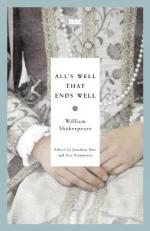|
This section contains 4,607 words (approx. 16 pages at 300 words per page) |

|
SOURCE: “Imperial Love and the Dark House: All's Well That Ends Well,” in Shakespeare's Development and the Problem Comedies: Turn and Counter-Turn, University of California Press, 1981, pp. 45-56.
In the following excerpt, Wheeler examines the comic patterns of All's Well That Ends Well, claiming that they “radically change the comic spirit of All's Well from that of earlier comedies.”
lavatch That man should be at woman's command, and yet no hurt done! (I.iii.87-88)
Northrop Frye, in “The Argument of Comedy,” called attention to the unusual turn Shakespeare gives the typical comic pattern in All's Well:
The normal comic resolution is the surrender of the senex to the hero, never the reverse. Shakespeare tried to reverse the pattern in All's Well That Ends Well, where the king of France forces Bertram to marry Helena, and the critics have not yet stopped making faces over it.1
In Shakespeare's...
|
This section contains 4,607 words (approx. 16 pages at 300 words per page) |

|


